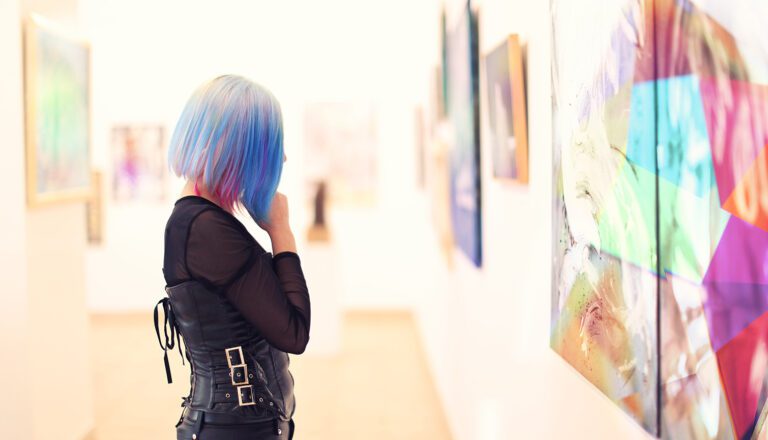Want to think more critically? Can art help?

In his famous essay “Critical thinking: What It Is and Why It Counts”, Dr. Peter Facione defines critical thinking as: “Purposeful, self-regulatory judgment which results in interpretation, analysis, evaluation, and inference, as well as explanation of the evidential, conceptual, methodological, criteriological, or contextual considerations upon which that judgment is based.”
Supporting the critical thinking skills of our students is an essential part of UNYP’s mission of creating an educated community of future professionals.
Critical thinking is a hot topic among journalists and scientists, but most importantly, among educators. One question academics continuously hear from students is, “How can critical thinking help me in achieving success?” The demand for university graduates who have complex reasoning skills, in addition to specific career-relevant skills, has grown over the past decade. According to the recent research by the World Economic Forum (WEF), complex problem-solving and critical thinking are at the top of the list of skills that will be most desired by employers by the year 2020!
For this article, we interviewed Dr. Ewa Grigar, who received her Ph.D. degree in sociology from the New School of Social Research in New York. Her dissertation work and present research are in the field of sociology of arts and culture. Apart from earning a Ph.D. and M.A. in sociology, she also holds a Master of Art History, Theory, and Criticism degree (with focus on Contemporary Art) from the School of the Art Institute in Chicago. Last semester, for the first time at UNYP, Dr. Grigar offered an Introduction to Drawing and Design course.
Why in your opinion is it important to teach art to non-art majors?
While this question can be answered from multiple angles, to keep it concise, I will try to explain it from a sociological perspective, since I am a sociologist of culture and, after Pierre Bourdieu, consider one’s cultural capital to be the most important social asset of a person, which helps them to move upwards in society. Studying art, as a cultural component: its theory and practice, offers an exceptionally interdisciplinary application that only positively strengthens the core philosophy, understanding, and life application of other scholarly disciplines. To give you an example, to teach mathematics, more primary schools nowadays use educational material full of visual imagery, which accommodates more effective problem solving and makes more students enjoy the subject.
Critical thinking, on the other hand, can make easier decisions when choosing the appropriate tools to solve issues at stake. In the world of research, critical thinking is essential for making a decision in selecting the best type of research tools in testing a hypothesis. If I were to use a metaphor, I would say that each academic discipline offers its own language of communication to better understand the surrounding world. The role of art here is that of the ink which makes that language visible to others who can further interpret it…
The latest social changes in our society, attributed by scholars to the emergence of “the information age,” have sparked increased attention to the need for restoring the teaching of critical and creative thinking, naturally, through art education. When we look at the surrounding world, we see that more than ever, visual images are becoming prioritized over the spoken or written word (think about many minimalistic ads and marketing initiatives) – form over context kind of dialogue. Not surprisingly we register enormous popularity in communication through Facebook, Instagram, Snapchat, Twitter, and other social networking sites. This is somehow ironic if we consider that one of the main reasons why Catholic Church was investing so much into the painting of biblical scenes by famous painters of their time was to inform a somewhat illiterate society (i.e., sources state that less than 20% of the inhabitants of Europe were literate in the mid-1500s). Yet, due to social changes in our society, and also in terms of how we gain and use knowledge, we see that aesthetic consciousness plays a highly important role here, as it shapes our culture today and will further shape it in the future.
How do you lead an open-ended discussion with your students focused on a work of art?
When we discuss a particular work of art, I ask students to discuss aesthetics and go deeply beyond a simple explanation of “I like it” or “this is nice.” Those students who took Intro to Drawing and Design this past Spring were not allowed to use these generic statements during class critiques, and were asked to delve deeper into explaining WHAT they like and WHY they prefer a particular piece. Also, many works of art which we discuss in my classes are often works infused with a political or social statement. We would often discuss if the message has been clearly communicated or not, or if the use of different media offered a more or less forceful statement. Needless to say, I strongly encourage students to think critically about what they see. This, of course, also pertains to viewing the world around us and the issues we deal with in our everyday life. I can easily equate the craft of talking about art to that of solving a riddle, by connecting different dots for the entire picture to emerge.
Related Articles
UNYP Chronicle Newsletter
The e-mail address you provide will be used only to send you the newsletter. Your privacy is important to us.
For more information download our UNYP Brochure.

Contacts
University of New York in Prague
Londýnská 41, 120 00 Praha
ID no: 25676598
Phone:
+420 224 221 261
![]() Skype
Skype
Email: unyp@unyp.cz







